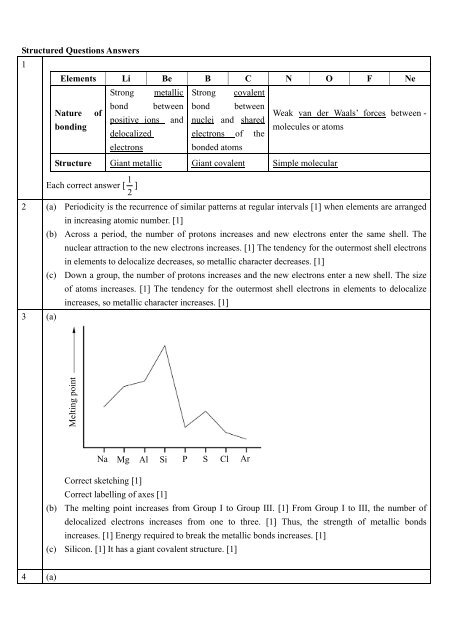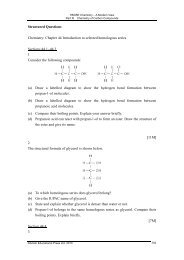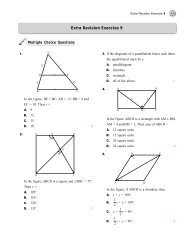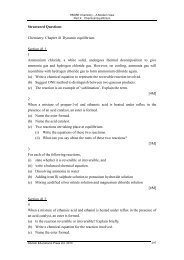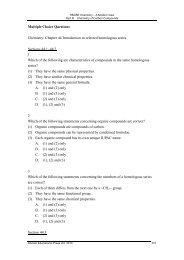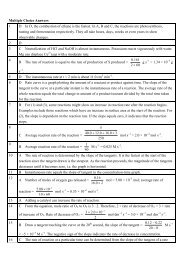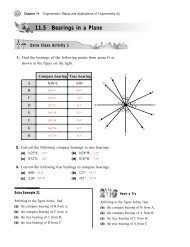Structured Questions Answers 1 Elements Li Be B C N O F Ne ...
Structured Questions Answers 1 Elements Li Be B C N O F Ne ...
Structured Questions Answers 1 Elements Li Be B C N O F Ne ...
You also want an ePaper? Increase the reach of your titles
YUMPU automatically turns print PDFs into web optimized ePapers that Google loves.
<strong>Structured</strong> <strong>Questions</strong> <strong>Answers</strong><br />
1<br />
<strong>Elements</strong> <strong>Li</strong> <strong>Be</strong> B C N O F <strong>Ne</strong><br />
Strong metallic Strong covalent<br />
bond between bond between<br />
Nature of<br />
Weak van der Waals’ forces between -<br />
positive ions and nuclei and shared<br />
bonding<br />
molecules or atoms<br />
delocalized electrons of the<br />
electrons<br />
bonded atoms<br />
Structure Giant metallic Giant covalent Simple molecular<br />
1<br />
Each correct answer [ ] 2<br />
2 (a) Periodicity is the recurrence of similar patterns at regular intervals [1] when elements are arranged<br />
in increasing atomic number. [1]<br />
(b) Across a period, the number of protons increases and new electrons enter the same shell. The<br />
nuclear attraction to the new electrons increases. [1] The tendency for the outermost shell electrons<br />
in elements to delocalize decreases, so metallic character decreases. [1]<br />
(c) Down a group, the number of protons increases and the new electrons enter a new shell. The size<br />
of atoms increases. [1] The tendency for the outermost shell electrons in elements to delocalize<br />
increases, so metallic character increases. [1]<br />
3 (a)<br />
Melting point<br />
Na Mg Al Si P S Cl Ar<br />
Correct sketching [1]<br />
Correct labelling of axes [1]<br />
(b) The melting point increases from Group I to Group III. [1] From Group I to III, the number of<br />
delocalized electrons increases from one to three. [1] Thus, the strength of metallic bonds<br />
increases. [1] Energy required to break the metallic bonds increases. [1]<br />
(c) Silicon. [1] It has a giant covalent structure. [1]<br />
4 (a)
Melting point<br />
Na Mg Al Si P S Cl Ar<br />
(b)<br />
Correct sketching [1]<br />
Correct labelling [1]<br />
Relative electrical<br />
conductivity<br />
Na Mg Al Si P S Cl Ar<br />
(c)<br />
Correct sketching [1]<br />
Correct labelling [1]
Relative electrical<br />
conductivity<br />
<strong>Li</strong> <strong>Be</strong> B C N O F <strong>Ne</strong><br />
5<br />
Correct sketching [1]<br />
Correct labelling [1]<br />
In Period 2, only <strong>Li</strong> and <strong>Be</strong> can conduct electricity. [1] There are three elements in Period 3 which<br />
can conduct electricity. [1]<br />
1<br />
(a) Element with a giant covalent structure (i.e. Si) has the highest melting point in the period. [ ] 2<br />
<strong>Be</strong>fore melting can occur, most of the covalent bonds have to be broken [ 2<br />
1 ] and a large amount of<br />
energy is needed to overcome the strong covalent bonds. [ 2<br />
1 ]<br />
For elements with giant metallic structures (i.e. Na, Mg and Al), the metallic bonds do not have to<br />
be substantially broken to form a liquid. [ 2<br />
1 ] Thus, the melting points of metals are not as high as<br />
that of Si. [ 2<br />
1 ]<br />
In melting simple molecular substances (i.e. P, S, Cl and Ar), much less energy is needed to<br />
overcome the weak intermolecular forces. [ 2<br />
1 ] Therefore, they have much lower melting points.<br />
[ 2<br />
1 ]<br />
(b) Metals in this period (i.e. Na, Mg and Al) contain delocalized electrons, [ 2<br />
1 ] so they can conduct<br />
electricity. [ 2<br />
1 ] With the increasing number of valence electrons, [ 2<br />
1 ] electrical conductivities<br />
increase from Na to Al. [ 2<br />
1 ]<br />
For elements with a giant covalent structure (i.e. Si) [ 2<br />
1 ] or a simple molecular structure (i.e. P, S,
Cl and Ar), [ 2<br />
1 ] the absence of delocalized electrons makes them insulators of electricity. [ 2<br />
1 ]<br />
6 (a)<br />
Melting point<br />
Na<br />
Mg<br />
Al<br />
Si<br />
P S Cl Ar<br />
Correct trend of melting points from Na to Si [1]<br />
Correct trend of melting points from P to Ar [1]<br />
(b) Carbon has a giant covalent structure. The atoms are held by strong covalent bonds. [1] In melting,<br />
most of the strong covalent bonds have to be broken. [1] A large amount of energy is needed, [1]<br />
so the melting point is very high.<br />
7 (a) Graphite. [1]<br />
There are delocalized electrons in each layer of graphite. [1]<br />
(b) In diamond, each carbon atom is covalently bonded to four other atoms, forming a<br />
three-dimensional giant network. [1] To break the structure, numerous strong covalent bonds<br />
between carbon atoms must be broken. [1] This makes diamond extremely hard.<br />
In graphite, each carbon atom is covalently bonded to three other atoms. The carbon atoms are<br />
arranged in flat, parallel layers. [1] Only weak van der Waals’ forces exist between adjacent layers.<br />
[1] This makes graphite crystal easy to cleave.<br />
(c) Giant covalent structure [1]<br />
8 (a)<br />
Melting point<br />
<strong>Li</strong> <strong>Be</strong> B C N O F <strong>Ne</strong>
(b)<br />
Correct sketching [1]<br />
Correct labelling [1]<br />
Melting point<br />
Na<br />
Mg<br />
Al<br />
Si<br />
P S Cl<br />
Ar<br />
Correct sketching [1]<br />
Correct labelling [1]<br />
(c) Each lithium and sodium atom contributes one delocalized electron into the ‘electron sea’. [1] Due<br />
to the smaller size, lithium ion has a stronger attraction on the delocalized electrons than sodium.<br />
[1] Therefore, the metallic bonds in lithium are stronger. <strong>Li</strong>thium has a higher melting point. [1]<br />
(d) Fluorine and chlorine have simple molecular structures. [1] Chlorine has a larger molecular size<br />
than fluorine, so chlorine has stronger van der Waals’ forces between molecules. [1] Therefore,<br />
chlorine has a higher melting point. [1]<br />
(e) Carbon and silicon have giant covalent structures. [1] Since a CC bond is stronger than a SiSi<br />
bond, [1] more energy is needed to break the covalent bonds between carbon atoms. Therefore,<br />
carbon has a higher melting point. [1]<br />
9 (a)<br />
Relative electrical<br />
conductivity<br />
Na<br />
Mg<br />
Al<br />
Si<br />
P S Cl Ar<br />
Correct sketching [1]<br />
Correct labelling [1]
(b) Electrical conductivity depends on the number of delocalized electrons per atom. [1] Since<br />
magnesium has two outermost shell electrons while sodium has only one, [1] magnesium has a<br />
higher electrical conductivity. [1]<br />
10 (a) x = 6 [1]<br />
(b) The one with atomic number of x + 4. [1]<br />
(c) Si has a giant covalent structure [1] in which electrons are not free to move. [1]<br />
(d) Al has a larger number of delocalized electrons than Mg. [1] Therefore, the electrical conductivity<br />
of Al is higher.<br />
11 (a) Period 2 [1]<br />
(b) No. [1] All the three elements have simple molecular structures and they have similar molecular<br />
sizes. [1]<br />
(c) The student is incorrect. [1] Although phosphorus (P 4 ) also has a simple molecular structure, the<br />
molecular size of phosphorus is significantly larger [1] than the above three elements. The van der<br />
Waals’ forces between phosphorus molecules are much stronger, so the melting point of<br />
phosphorus is much higher. [1]<br />
12 (a) Na, Mg, Al: giant metallic [1]<br />
Si: giant covalent [1]<br />
P, S, Cl, Ar: simple molecular [1]<br />
(b) (i) The melting point of a substance is the temperature at which it changes from a solid to a<br />
liquid. [1]<br />
(ii)<br />
Melting point<br />
Na<br />
Mg<br />
Al<br />
Si<br />
P S Cl Ar<br />
Correct sketching [1] , Correct labelling [1]<br />
(iii) Si has a giant covalent structure and it has the highest melting point across the period. In<br />
melting, most of the covalent bonds have to be broken. [1] A large amount of energy is<br />
needed to overcome the strong covalent bonds. [1]<br />
From Na to Al, they have giant metallic structures and the metallic bonds do not have to be<br />
substantially broken to form a liquid. [1] Thus, the melting points of the metals are lower than<br />
Si. [1] Due to the increase in number of delocalized electrons, melting point increases from<br />
Na to Al. [1]
13 (a)<br />
Element Electronic<br />
configuration<br />
Physical state<br />
at 25C<br />
Melting point<br />
(1-highest, 4-lowest)<br />
Electrical<br />
conductivity<br />
W 2, 1 Solid 2 conductor<br />
X 2, 3 Solid 1 depends on<br />
temperature<br />
Y 2, 8, 6 Solid 3 insulator<br />
Z 2, 8, 8 Gas 4 insulator<br />
Each correct answer [ 2<br />
1 ]<br />
(b) (i) W: <strong>Li</strong>thium [ 2<br />
1 ]<br />
X: Boron [ 2<br />
1 ]<br />
Y: Sulphur [ 2<br />
1 ]<br />
Z: Argon [ 2<br />
1 ]<br />
(ii) Metal: W [ 2<br />
1 ]<br />
1<br />
Semi-metal: X [ ] 2<br />
Non-metal: Y, Z [1]<br />
1<br />
(c) X is a semi-metal and it has a giant covalent structure. [ ] Atoms of X are held together by strong<br />
2<br />
covalent bonds. A large amount of energy is needed to overcome the strong covalent bonds before<br />
1<br />
melting can occur, [ ] so it has the highest melting point.<br />
2<br />
W is a metal. It has a giant metallic structure [ 2<br />
1 ] and the atoms are held by strong metallic bonds.<br />
1<br />
However, the metallic bonds do not have to be substantially broken to form a liquid, [ ] so its 2<br />
melting point is not as high as X.<br />
For Y and Z, they have simple molecular structures. Much less energy is needed to overcome the<br />
1<br />
weak van der Waals’ forces, [ ] so they have lower melting points than X and W. Since Y has a<br />
2<br />
larger molecular size than Z, [ 2<br />
1 ] Y has a higher melting point than Z.<br />
(d) W is a metal, so it contains delocalized electrons to conduct electricity. [ 2<br />
1 ]
X is a semi-metal. Its electrons are not free to move at room temperature, [ 2<br />
1 ] so it is an insulator<br />
at room temperature. However, at higher temperatures, it conducts electricity as the electrons are<br />
free to move. [ 2<br />
1 ]<br />
(e) X:<br />
Y and Z are non-metals. Their electrons are not free to move, [ 2<br />
1 ] so they cannot conduct<br />
electricity.<br />
Y:<br />
[1]<br />
[1]<br />
14 (a) <strong>Li</strong>: alkali metal [1]<br />
<strong>Be</strong>: alkaline earth metal [1]<br />
F: halogen [1]<br />
<strong>Ne</strong>: noble gas/inert gas [1]<br />
(b) (i) Carbon can exist as diamond and graphite. For diamond, it has a giant covalent structure and<br />
all four outermost shell electrons in each carbon atom are used for formation of covalent<br />
bonds. [1] There are no delocalized electrons in its structure, so diamond is an insulator of<br />
electricity. [1] On the other hand, graphite also has a giant covalent structure. Three of the<br />
outermost shell electrons in each carbon atom are used for formation of covalent bonds. [1]<br />
There is one electron left which is free to move and conduct electricity. [1] Therefore,<br />
graphite is an conductor of electricity.<br />
(ii) Diamond:<br />
Graphite:<br />
[1]
[1]<br />
(c) (i) <strong>Be</strong> has a larger number of delocalized electrons [1] than <strong>Li</strong>. The metallic bonds in <strong>Be</strong> are<br />
stronger and more energy is needed to break the bonds, [1] so <strong>Be</strong> has a higher melting point<br />
than <strong>Li</strong>.<br />
(ii) F and <strong>Ne</strong> have simple molecular structures. [1] In melting the solid, much less energy is<br />
needed to overcome the weak intermolecular forces. [1] Therefore, they have relatively lower<br />
melting points.<br />
15 (a) Both have giant metallic structures. [1] <strong>Be</strong>ryllium has two outermost shell electrons while lithium<br />
has only one. [1] Metallic bonds in beryllium are stronger than those in lithium. [1] Therefore,<br />
beryllium has a higher melting point than lithium.<br />
(b) Carbon has a giant covalent structure while nitrogen has a simple molecular structure. [1] The<br />
covalent bonds between carbon atoms are much stronger than the weak van der Waals’ forces<br />
between nitrogen molecules. [1] Much more energy is needed to break the strong covalent bonds<br />
between carbon atoms, [1] so carbon has a higher melting point.<br />
(c) <strong>Li</strong>thium has a giant metallic structure while fluorine has a simple molecular structure. [1] The<br />
metallic bonds in lithium are much stronger than the weak van der Waals’ forces between fluorine<br />
molecules. [1] Much more energy is needed to break the strong metallic bonds in lithium, [1] so<br />
lithium has a higher melting point.<br />
16 (a) Both of them have giant metallic structures. [1] They contain delocalized electrons to conduct<br />
electricity. [1] Going from sodium to aluminium, the number of delocalized electrons increases. [1]<br />
Therefore, the electrical conductivities also increase.<br />
(b) Both have giant covalent structures. [1] Graphite has a layered structure in which each carbon<br />
atom is bonded to three other atoms and delocalized electrons are present in each layer to conduct<br />
electricity. [1] Diamond has a giant three-dimensional network in which each carbon atom is<br />
bonded to four other atoms, so there are no delocalized electrons in diamond. [1]<br />
(c) Boron has a giant covalent structure and it does not have delocalized electrons. [1] Aluminium has<br />
a giant metallic structure and it contains delocalized electrons to conduct electricity. [1]<br />
17 The student is partly correct. [1]<br />
Metals contain delocalized electrons which are free to move [1]. Therefore, metals are conductors of<br />
electricity.<br />
For graphite, although it is a non-metal, [1] it contains delocalized electrons in each layer of its<br />
structure. [1] These electrons are free to move along the layers. [1] Therefore, graphite is also an<br />
electrical conductor.
18 (a) Electronegativity is a measure of the tendency of an atom to attract a bonding pair of electrons. [1]<br />
(b) Na 2 O. [1] The difference in electronegative values between Na and O is larger than that between<br />
Al and O. [1]<br />
(c) Na 2 O 2 [1]<br />
O.N. of O = 1 [1]<br />
(d) 6Na(s) + 2O 2 (g) 2Na 2 O(s) + Na 2 O 2 (s) [1]<br />
19<br />
Oxide Na 2 O MgO Al 2 O 3 SiO 2 P 4 O 10 SO 2 Cl 2 O<br />
Colour and<br />
Colourless Orange<br />
state at<br />
White solid<br />
gas gas<br />
25C<br />
Giant<br />
Structure<br />
Giant ionic<br />
Simple molecular<br />
covalent<br />
Acid-base<br />
property<br />
Basic Amphoteric Acidic<br />
Each correct blank [1]<br />
20 (a) Across Period 3, the electronegativities of elements change from low values on the left to high<br />
values on the right. [1]<br />
(b) The difference in electonegativity values between the element and oxygen decreases across a<br />
period, [1] so the bonding of the oxides becomes less ionic and more covalent. [1] Therefore, the<br />
structure of the oxides changes from giant ionic to giant covalent, and then simple molecular. [1]<br />
(c) Basic oxides react with water to form hydroxides and with dilute acids to form salts. [1] Example:<br />
sodium oxide. [1]<br />
Acidic oxides react with water to give acids and with dilute alkalis to form salts. [1] Example:<br />
Sulphur dioxide. [1]<br />
21 (a) X: Na [1]<br />
Y: Al [1]<br />
Z: Cl [1]<br />
(b) Na 2 O reacts vigorously with water to form sodium hydroxide solution. [1]<br />
Na 2 O(s) + H 2 O(l) 2NaOH(aq) [1]<br />
Al 2 O 3 is insoluble in water. [1]<br />
1<br />
Cl 2 O reacts readily with water to form hypochlorous acid. [ ] Hypochlorous acid ionizes slightly<br />
2<br />
in water to form hydrogen ions and hypochlorite ions. [ 2<br />
1 ]<br />
Cl 2 O(g) + H 2 O(l) 2HOCl(aq) [ 2<br />
1 ]<br />
HOCl(aq) H + (aq) + OCl (aq) [ 2<br />
1 ]
22 (a) Na 2 O, MgO, Al 2 O 3 , SiO 2 , P 4 O 10 , SO 2 [3]<br />
(DO NOT accept Na 2 O 2 as one of the answers.)<br />
(b) P 4 O 10 (s) + 6H 2 O(l) 4H 3 PO 4 (aq) [1]<br />
(c) 4Al(s) + 3O 2 (g) 2Al 2 O 3 (s) [1]<br />
(d) SiO 2 (s) + 2OH (aq) SiO 2 3 (aq) + H 2 O(l) [1]<br />
(e) Cl 2 O(g) + H 2 O(l) 2HOCl(aq) [1]<br />
23 (a) B. [1] It has the lowest melting point. [1]<br />
(b) Giant covalent structure [1]<br />
(c) SiO 2 [1]<br />
(d) Sodium oxide [1]<br />
Giant ionic structure [1]<br />
24 (a) (i) Amphoteric oxide [1]<br />
(ii) Al 2 O 3 (s) + 6HCl(aq) 2AlCl 3 (aq) + 3H 2 O(l) [1]<br />
Al 2 O 3 (s) + 2KOH(aq) + 3H 2 O(l) 2KAl(OH) 4 (aq) [1]<br />
(iii) <strong>Be</strong>O(s) + H 2 SO 4 (aq) <strong>Be</strong>SO 4 (aq) + H 2 O(l) [1]<br />
<strong>Be</strong>O(s) + 2NaOH(aq) + 3H 2 O(l) Na 2 <strong>Be</strong>(OH) 4 [1]<br />
(b) (i)<br />
[1]<br />
(ii) P 4 O 6 (s) + 6H 2 O(l) 4H 3 PO 3 (aq) [1]<br />
P 4 O 10 (s) + 6H 2 O(l) 4H 3 PO 4 (aq) [1]<br />
25 (a) Glass contains mainly silicon dioxide, [1] which is acidic and can react with sodium hydroxide. [1]<br />
SiO 2 (s) + 2NaOH(aq) Na 2 SiO 3 (aq) + H 2 O(l) [1]<br />
(b) Sodium silicate [1]<br />
(c) Use dilute alkalis as titrant. [1]<br />
Rinse the burette throughout after experiment. [1]<br />
(d) Sodium hydroxide pellets absorb water from the air, [1] so it is not possible to accurately weigh<br />
them. [1]<br />
26 (a) (i) Sulphur dioxide:<br />
[1]<br />
Sulphur trioxide:<br />
[1]<br />
(ii) 2SO 2 (g) + O 2 (g) 2SO 3 (g) [1]<br />
Vanadium(V) oxide/V 2 O 5 [1]<br />
(iii) Colourless [1]
(b) (i) [1]<br />
(ii) Orange [1]<br />
27 (a) Na 2 O:<br />
The compound is soluble in water. [1]<br />
Na 2 O(s) + H 2 O(l) 2NaOH(aq) [1]<br />
Al 2 O 3 :<br />
The compound is insoluble in water. [1]<br />
SiO 2 :<br />
The compound is insoluble in water. [1]<br />
(b) The solution made with Na 2 O is alkaline. [1]<br />
The liquid obtained by mixing Al 2 O 3 with water is neutral. [1]<br />
The liquid obtained by mixing SiO 2 with water is neutral. [1]<br />
(c) Al 2 O 3 (s) + 6HNO 3 (aq) 2Al(NO 3 ) 3 (aq) + 3H 2 O(l) [1]<br />
Al 2 O 3 (s) + 2NaOH(aq) + 3H 2 O(l) 2NaAl(OH) 4 (aq) [1]<br />
(d) Amphoteric [1]<br />
28 (a) Phosphorus pentoxide:<br />
Sulphur dioxide:<br />
[1]<br />
[1]<br />
(b) MgO: MgO(s) + H 2 O(l) Mg(OH) 2 (s) [1]<br />
P 4 O 10 : P 4 O 10 (s) + 6H 2 O(l) 4H 3 PO 4 (aq) [1]<br />
SO 2 : SO 2 (g) + H 2 O(l) H 2 SO 3 (aq) [1]<br />
(c) P 4 O 10 [1]<br />
29 (a)<br />
Correct ratio of elements [1]
Correct arrangement of elements [1]<br />
(b) Statement (1) is correct. [1] SiO 2 is acidic, so it will react with alkalis to form salts. [1]<br />
Statement (2) is incorrect [1] since SiO 2 will not react with acids. [1]<br />
30 (a) The universal indicator turns red. [1] P 4 O 10 reacts with water to form phosphoric acid. [1]<br />
P 4 O 10 (s) + 6H 2 O(l) 4H 3 PO 4 (aq) [1]<br />
(b) As a desiccant/dehydrating agent. [1]<br />
(c) The student is incorrect. [1] An intact molecule of P 4 O 10 consists of 4 phosphorus atoms and 10<br />
oxygen atoms. [1]<br />
[1]<br />
31 (a) (i) Silicon dioxide [1]<br />
(ii) Covalent [1]<br />
(b) (i) Orange [1]<br />
(ii) This indicates that the solution is acidic. [1] Glass contains mainly silicon dioxide, which<br />
react with the alkaline solution. The reaction mixture becomes acidic since some OH (aq)<br />
ions are removed. [1]<br />
(iii) Metal oxides [1]<br />
(c) (i) This is because sodium hydroxide will react with silicon oxide to corrode the glass bottle. [1]<br />
(ii) Plastic bottle [1]<br />
32 (a) Metal oxides: B, D [1]<br />
1<br />
Semi-metal oxide: C [ ] 2<br />
Non-metal oxide: A [ 2<br />
1 ]<br />
(b) Acidic oxides: A, C [1]<br />
Amphoteric oxide: D [ 2<br />
1 ]<br />
Basic oxide: B [ 2<br />
1 ]<br />
(c) C: Silicon dioxide/SiO 2 [ 2<br />
1 ]<br />
D: Aluminium oxide/Al 2 O 3 [ 2<br />
1 ]<br />
For oxides of the elements across Period 3, only Al 2 O 3 and SiO 2 are insoluble in water. [1] Al 2 O 3<br />
is amphoteric and it reacts with both dilute acids and alkalis. [1] SiO 2 is acidic and it reacts with<br />
dilute alkalis. [1]
(d) A has the lowest melting point. [1] A is a non-metal oxide and it has a simple molecular structure.<br />
[1] Its discrete molecules are held together by weak van der Waals’ forces only. In melting the<br />
solid, small amount of energy is needed to overcome the weak intermolecular forces, [1] so it has a<br />
relatively low melting point.<br />
33 (a) The oxides changes from basic, through amphoteric, to acidic. [1]<br />
(b) Al 2 O 3 [1]<br />
Al 2 O 3 reacts with dilute acids to form salts.<br />
Al 2 O 3 (s) + 3H 2 SO 4 (aq) Al 2 (SO 4 ) 3 (aq) + 3H 2 O(l) [1]<br />
Al 2 O 3 reacts with dilute alkalis to form aluminate ions.<br />
Al 2 O 3 (s) + 2NaOH(aq) + 3H 2 O(l) 2NaAl(OH) 4 (aq) [1]<br />
(c) SO 2 and Cl 2 O [2]<br />
(d) (i) P 4 O 10 (s) + 6H 2 O(l) 4H 3 PO 4 (aq) [1]<br />
(ii) Molecules of H 3 PO 4 are held together by hydrogen bonds. [1]<br />
hydrogen bond<br />
[1]<br />
(iii) It is a tribasic acid [1] because 3 hydrogen atoms from the three hydroxyl groups are capable<br />
of ionization. [1]/H 3 PO 4 (aq) 3H (aq) + PO 3 4 (aq) [1]<br />
34 (a) X = Magnesium [1]<br />
Y = Aluminium [1]<br />
Z = Silicon [1]<br />
(b) (i)<br />
[1]<br />
(ii) MgO(s) + H 2 O(l) Mg(OH) 2 (s) [1]<br />
Mg(OH) 2 (s) + water Mg 2+ (aq) + 2OH (aq) [1]<br />
(c) An amphoteric substance can act both as an acid and as a base. [1]<br />
Al 2 O 3 (s) + 6H + (aq) 2Al 3+ (aq) + 3H 2 O(l) [1]<br />
Al 2 O 3 (s) + 2OH (aq) + 3H 2 O(l) 2Al(OH) 4 (aq) [1]<br />
(d) SiO 2 has a giant covalent structure. [1]<br />
35 (a) Put the three solids into distilled water [1] and measure the pH of the solutions by pH meter. [1]<br />
1<br />
Aluminium oxide is insoluble in water. [ ] 2
pH of the solution does not change./pH = 7 [ 2<br />
1 ]<br />
Sodium oxide dissolves in water to give an alkaline solution. [ 2<br />
1 ]<br />
Na 2 O(s) + H 2 O(l) 2NaOH(aq) [ 2<br />
1 ]<br />
Phosphorus pentoxide dissolves in water to give an acidic solution. [ 2<br />
1 ]<br />
P 4 O 10 (s) + 6H 2 O(l) 4H 3 PO 4 (aq) [ 2<br />
1 ]<br />
(b) Aluminium oxide and sodium oxide have giant ionic structures. [ 2<br />
1 ] Their ions are held together<br />
by strong ionic bonds. [ 2<br />
1 ]<br />
Phosphorus pentoxide has a simple molecular structure. [ 2<br />
1 ] The molecules are held together by<br />
weak van der Waals’ forces. [ 2<br />
1 ]<br />
36 (a) Assume that there are 100 g of gallium oxide,<br />
Element Ga O<br />
Mass (g) 74.4 25.6<br />
Number of 74.4<br />
moles (mol) 69. 7<br />
mol = 1.07 mol<br />
25.6<br />
16.0<br />
mol = 1.60 mol [1]<br />
Mole ratio 2 3 [1]<br />
Empirical formula of gallium oxide is Ga 2 O 3 . [ 2<br />
1 ]<br />
Assume that there are 100 g of arsenic oxide,<br />
Element As O<br />
Mass (g) 65.2 34.8<br />
Number of 65.2<br />
moles (mol) 74. 9<br />
mol = 0.870 mol<br />
34.8<br />
16.0<br />
mol = 2.18 mol [1]<br />
Mole ratio 2 5 [1]<br />
Empirical formula of arsenic oxide is As 2 O 5 . [ 2<br />
1 ]<br />
(b) Gallium oxide has a giant ionic structure. [ 2<br />
1 ] The ions are held together by strong ionic bonds.<br />
[ 2<br />
1 ]
Arsenic oxide has a simple molecular structure. [ 2<br />
1 ] The molecules are held together by weak van<br />
1<br />
der Waals’ forces. [ ] 2<br />
37 (a) (i) P 4 O 10 reacts with water to give phosphorus acid. [1]<br />
P 4 O 10 (s) + 6H 2 O(l) 4H 3 PO 4 (aq) [1]<br />
SO 2 reacts with water to give sulphurous acid. [1]<br />
SO 2 (g) + H 2 O(l) H 2 SO 3 (aq) [1]<br />
(ii) Silicon dioxide has a giant covalent structure, so it cannot dissolve in water. [1] But it reacts<br />
with dilute alkalis to form salts. [1]<br />
SiO 2 (s) + 2OH (aq) SiO 2 3 (aq) + H 2 O(l) [1]<br />
1<br />
(b) SiO 2 has a giant covalent structure. [ ] The atoms are held together by strong covalent bonds.<br />
2<br />
[ 2<br />
1 ]<br />
SO 2 has a simple molecular structure. [ 2<br />
1 ] The molecules are held together by weak van der<br />
1<br />
Waals’ forces. [ ] 2<br />
(c) (i) Dehydrating agent [1]<br />
(ii) Manufacture of sulphuric acid/Preservative [1]<br />
38 (a) A substance is described as ‘amphoteric’ if it can act both as an acid and as a base. [1]<br />
(b) <strong>Be</strong>O/GeO 2 /SnO 2 /PbO 2 (Any ONE) [1]<br />
(c) (i) 2Al(OH) 3 (s) + 3H 2 SO 4 (aq) Al 2 (SO 4 ) 3 (aq) + 6H 2 O(l) [1]<br />
(ii) Al(OH) 3 (s) + NaOH(aq) NaAl(OH) 4 (aq) [1]<br />
(d) Electrolysis of molten aluminium oxide [1]<br />
39 (a) Generally, the outermost shells of the atoms of transition metals have either one or two electrons.<br />
[1] Due to this similar outer electron arrangement, [1] transition metals across a period have<br />
similar chemical properties.<br />
(b) Sodium atoms only have one outermost shell electron that contributes to the ‘sea of electrons’. [1]<br />
On the other hand, electrons in both the outermost shell and the next inner shell of copper atoms<br />
contribute to the ‘sea of electrons’. [1] Therefore, the strength of metallic bonds in copper is much<br />
stronger than that in sodium. [1] This makes copper much harder than sodium.<br />
(c) Iron(III) ions [1]<br />
(d) White [1]<br />
40 (a) Green [1]<br />
(b) (i) 2V 3+ (aq) + Zn(s) 2V 2+ (aq) + Zn 2+ (aq) [1]<br />
(ii) The solution changes from green to violet. [1]<br />
(c) (i) Vanadium(V) oxide/V 2 O 5 [1]<br />
(ii) The oxidation state of vanadium in V 2 O 5 is +5. [1]
(iii) Contact Process [1]<br />
41 (a) Fe 2+ and Fe 3+ . [1]<br />
(b) Fe 2+ [1]<br />
(c) The reaction mixture changes from green to yellow. [1]<br />
(d) 2Fe 2+ (aq) + Cl 2 (aq) 2Fe 3+ (aq) + 2Cl (aq) [1]<br />
42 (a) (i) Cr 3+ : +3 [1]<br />
Cr 2 O 2 7 : +6 [1]<br />
(ii) Cr 3+ : green [1]<br />
Cr 2 O 2 7 : orange [1]<br />
(b) (i) Cr 2 O 2 7 (aq) + 14H + (aq) + 6e 2Cr 3+ (aq) + 7H 2 O(l) [1]<br />
(ii) The solution changes from orange to green at the end point. [1]<br />
(iii) K 2 Cr 2 O 7 (aq) + 4H 2 SO 4 (aq) + 3H 2 S(g)<br />
Cr 2 (SO 4 ) 3 (aq) + K 2 SO 4 (aq) + 7H 2 O(l) + 3S(s) [1]<br />
K 2 Cr 2 O 7 (aq) + H 2 SO 4 (aq) + 3SO 2 (g)<br />
Cr 2 (SO 4 ) 3 (aq) + K 2 SO 4 (aq) + H 2 O(l) [1]<br />
(iv) Iodide ion is oxidized to iodine which is brown in aqueous solution. [1] This makes the end<br />
point difficult to be detected. [1]<br />
43 (a) It is because a variable number of electrons can be removed from the outermost shell and the next<br />
inner shell of the atoms of transition metals. [1]<br />
(b) (i) Copper and iron [2]<br />
(ii) Copper: Cu + ion and Cu 2+ ion [2]<br />
Iron: Fe 2+ ion and Fe 3+ ion [2]<br />
(c) Scandium and zinc [2]<br />
44 (a) The orange dichromate ions (Cr 2 O 2 7 (aq)) are reduced by ethanol to give chromium(III) ions<br />
(Cr 3+ (aq)) which are green in colour. [2]<br />
(b) The oxidation number of chromium in Cr 3+ (aq) is +3 [1] and that in Cr 2 O 2 7 (aq) is +6. [1]<br />
45 (a) The oxidation number of vanadium in VO + 2 is +5. [1]<br />
The oxidation number of vanadium in VO 2+ is +4. [1]<br />
(b) V 2+ (aq) ion is violet [1] and V 3+ (aq) ion is green. [1]<br />
(c) (i) 2SO 2 (g) + O 2 (g) 2SO 3 (g) [1]<br />
(ii) The oxidation number of vanadium in V 2 O 5 is +5. [1]<br />
(d) (i)<br />
1<br />
Stage 2: 2VO 2 (s) + O2 (g) V 2 O 5 (s) [1]<br />
2<br />
(ii) V 2 O 5 is considered to be a catalyst because it is regenerated at the end of the reactions. [1]<br />
46 (a) Decomposition of hydrogen peroxide [1]<br />
(b) (i) MnO 2 (s) + 4HCl(aq) MnCl 2 (aq) + 2H 2 O(l) + Cl 2 (g) [1]<br />
(ii) The colour of the resultant solution is very pale pink [1] due to the presence of Mn 2+ (aq) ions.<br />
[1]<br />
(c) (i) Purple [1]<br />
(ii) MnO 4 (aq) + 8H + (aq) + 5Fe 2+ (aq) Mn 2+ (aq) + 4H 2 O(l) + 5Fe 3+ (aq) [1]
47 (a) N 2 (g) + 3H 2 (g) 2NH 3 (g) [1]<br />
Finely divided iron [1]<br />
(b) 2SO 2 (g) + O 2 (g) 2SO 3 (g) [1]<br />
Vanadium(V) oxide/V 2 O 5 [1]<br />
(c) 2NO(g) + 2CO(g) N 2 (g) + 2CO 2 (g) [1]<br />
Platinum/Pt and rhodium/Rh [1]<br />
(d) 2H 2 O 2 (aq) 2H 2 O(l) + O 2 (g) [1]<br />
Manganese(IV) oxide/MnO 2 [1]<br />
(e)<br />
[1]<br />
Titanium(IV) chloride/TiCl 4 [1]<br />
48 (a) A catalyst alters the rate of a chemical reaction [1] without being used up in the process. [1]<br />
(b) (i) Vanadium(IV) oxide/VO 2 [1]<br />
(ii) It oxidizes X (VO 2 ) to V 2 O 5 , [1] so the catalyst is regenerated and is available for further<br />
catalysis. [1]<br />
(c) A catalyst provides an alternative pathway [1] with lower energy barrier/activation energy, [1] so<br />
more reactant particles can possess enough energy to have effective collisions. [1]<br />
49 (a) A: Fe 2+ [1]<br />
B: Fe 3+ [1]<br />
(b) Fe 2+ , I and SO 2 4 . [3]<br />
(c) Firstly, S 2 O 2 8 ions are reduced by A.<br />
2Fe 2+ (aq) + S 2 O 2 8 (aq) 2Fe 3+ (aq) + 2SO 2 4 (aq) [1]<br />
Secondly, I ions are oxidized by B.<br />
2Fe 3+ (aq) + I (aq) 2Fe 2+ (aq) + I 2 (aq) [1]<br />
50 (a) (i) A variable number of electrons [1] can be removed from the outermost shell and the next<br />
inner shell of the atoms of transition metals. [1]<br />
(ii) Electrons in both outermost shell and the next inner shell [1] of most transition metal atoms<br />
contribute to the ‘sea of electrons’. [1]<br />
(b) (i) Copper [1]<br />
(ii) Iron [1]<br />
(iii) Zinc [1]<br />
(iv) Titanium [1]<br />
51 (a) (i) 4Fe(s) + 2nH 2 O(l) + 3O 2 (g) 2Fe 2 O 3 • nH 2 O(s) [1]<br />
(ii) From 0 to +3 [1]<br />
(b) (i) The solution changes from colourless to green. [1]<br />
Gas bubbles are evolved. [1]<br />
(ii) Fe(s) + 2HCl(aq) FeCl 2 (aq) + H 2 (g) [1]<br />
(iii) It is a redox reaction. [1]<br />
The oxidation number of iron changes from 0 to +2. The oxidation number of hydrogen
changes from +1 to 0. [1]<br />
(c) (i) A catalyst alters the rate of a chemical reaction [1] without being used up in the process. [1]<br />
(ii) N 2 (g) + 3H 2 (g) 2NH 3 (g) [1]<br />
(d) (i) It oxidizes I to I 2 . [1]<br />
(ii) Iron(II) ions reduce peroxodisulphate ions to sulphate ions. [1] Then the iron(III) ions formed<br />
are reduced to iron(II) ions by iodide ions. [1]<br />
(iii) 2I (aq) + S 2 O 2 8 (aq) I 2 (aq) + 2SO 2 4 (aq) [1]<br />
52 (a) The oxidation state of manganese in MnSO 4 is +2. [1]<br />
The oxidation state of manganese in MnO 2 is +4. [1]<br />
The oxidation state of manganese in KMnO 4 is +7. [1]<br />
(b) (i) Manganese(IV) oxide [1]<br />
(ii) Decomposition of hydrogen peroxide [1]<br />
53 (a) Fe(s) + 2HCl(aq) FeCl 2 (aq) + H 2 (g) [1]<br />
2Fe(s) + 3Cl 2 (g) 2FeCl 3 (aq) [1]<br />
(b) Adding sodium hydroxide solution to the test tubes containing iron(II) chloride solution and<br />
iron(III) chloride solution respectively. [1]<br />
A green precipitate can be observed in the test tube containing iron(II) chloride solution. [1]<br />
A yellow/brown precipitate can be observed in the test tube containing iron(III) chloride solution.<br />
[1]<br />
(c) Iodide ions reduce iron(III) ions to give iron(II) ions as the intermediate. Iodide ions are oxidized<br />
to iodine as one of the products. [1]<br />
2Fe 3+ (aq) + 2I (aq) 2Fe 2+ (aq) + I 2 (aq) [1]<br />
Iron(II) ions reduce peroxodisulphate ions to give sulphate ions. Iron(II) ions are oxidized to<br />
iron(III) ions. [1]<br />
2Fe 2+ (aq) + S 2 O 2 8 (aq) 2Fe 3+ (aq) + 2SO 2 4 (aq) [1]<br />
54 (a) 2I (aq) + S 2 O 2 8 (aq) I 2 (aq) + 2SO 2 4 (aq) [1]<br />
(b) Firstly, iodide ions reduce iron(III) ions to give iron(II) ions as the intermediate. Iodide ions are<br />
oxidized to iodine as one of the products. [1]<br />
2Fe 3+ (aq) + I (aq) 2Fe 2+ (aq) + I 2 (aq) [1]<br />
Secondly, iron(II) ions reduce peroxodisulphate ions to give sulphate ions. Iron(II) ions are<br />
oxidized to iron(III) ions. Thus, iron(III) ions are regenerated. [1]<br />
2Fe 2+ (aq) + S 2 O 2 8 (aq) 2Fe 3+ (aq) + 2SO 2 4 (aq) [1]<br />
(c) It is essential for the synthesis of haemoglobin. [1]<br />
55 (a) (i) Displacement reaction [1]<br />
(ii) Zn(s) + CuSO 4 (aq) ZnSO 4 (aq) + Cu(s) [1]<br />
(b) Zinc ribbons dissolve. [1]<br />
Reddish brown solid is formed. [1]<br />
Blue colour of the solution fades. [1]<br />
(c) Zinc: making dry batteries/production of brass/as anti-corrosion coating for iron (Any ONE) [1]<br />
Copper: making electrical cables and wirings/making water taps and pipes/production of alloys
(Any ONE) [1]<br />
(Accept other reasonable answers.)<br />
56 (a) Platinum [1] and rhodium. [1]<br />
(b) 2NO(g) + 2CO(g) N 2 (g) + 2CO 2 (g) [1]<br />
(c) Iron is essential for the synthesis of haemoglobin in human body. [1]<br />
(d) High mechanical strength/low density/resistant to corrosion/can withstand extreme temperatures<br />
(Any TWO) [2]


